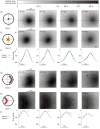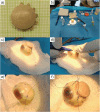Tumor Shape-Specific Brachytherapy Implants by 3D-Printing, Precision Radioactivity Painting, and Biomedical Imaging
- PMID: 37536742
- PMCID: PMC11468949
- DOI: 10.1002/adhm.202300528
Tumor Shape-Specific Brachytherapy Implants by 3D-Printing, Precision Radioactivity Painting, and Biomedical Imaging
Abstract
In brachytherapy (BT), or internal radiation therapy, cancer is treated by radioactive implants. For instance, episcleral plaques (EPs) for the treatment of uveal melanoma, are designed according to generic population approximations. However, more personalized implants can enhance treatment precision through better adjustment of dose profiles to the contours of cancerous tissues. An original approach integrating biomedical imaging, 3D printing, radioactivity painting, and biomedical imaging, is developed as a workflow for the development of tumor shape-specific BT implants. First, computer-aided design plans of EP are prepared according to guidelines prescribed by the Collaborative Ocular Melanoma Study protocol. Polyetheretherketone (PEEK), a high-performance polymer suitable for permanent implants, is used to 3D-print plaques and the geometrical accuracy of the printed design is evaluated by imaging. The possibility to modulate the dose distribution in a tridimensional manner is demonstrated by painting the inner surfaces of the EPs with radioactive 103Pd, followed by dose profile measurements. The possibility to modulate dose distributions generated by these 3D-printed plaques through radioactivity painting is therefore confirmed. Ex vivo surgical tests on human eyeballs are performed as an assessment of manipulation ease. Overall, this work provides a solution for the fabrication of tumor-specific radioactive implants requiring higher dose precision.
Keywords: 3D printing metrology; additive manufacturing of polymers; brachytherapy; brachytherapy dosimetry; episcleral plaques; polyetheretherketone (PEEK); uveal melanoma.
© 2023 The Authors. Advanced Healthcare Materials published by Wiley-VCH GmbH.
Conflict of interest statement
The authors declare no conflict of interest.
Figures










Similar articles
-
3D-printed radiopaque episcleral plaques with radioactive collimating cavities for enhanced dose delivery in brachytherapy.Brachytherapy. 2025 Mar-Apr;24(2):354-363. doi: 10.1016/j.brachy.2024.12.001. Epub 2025 Jan 30. Brachytherapy. 2025. PMID: 39890553
-
Palladium 103 plaque radiotherapy for uveal melanoma. Clinical experience.Ophthalmology. 1994 Feb;101(2):256-63. doi: 10.1016/s0161-6420(94)31338-8. Ophthalmology. 1994. PMID: 8115147 Clinical Trial.
-
A novel 3D printing method for a notched eye plaque "dummy" for uveal melanoma brachytherapy.Brachytherapy. 2025 Jan-Feb;24(1):86-91. doi: 10.1016/j.brachy.2024.09.002. Epub 2024 Nov 13. Brachytherapy. 2025. PMID: 39537436
-
Expert consensus on computed tomography-assisted three-dimensional-printed coplanar template guidance for interstitial permanent radioactive 125I seed implantation therapy.J Cancer Res Ther. 2019;15(7):1430-1434. doi: 10.4103/jcrt.JCRT_434_19. J Cancer Res Ther. 2019. PMID: 31939420 Review.
-
Brachytherapy and 3D printing for skin cancer: A review paper.J Contemp Brachytherapy. 2024 Apr;16(2):156-169. doi: 10.5114/jcb.2024.137357. Epub 2024 Mar 28. J Contemp Brachytherapy. 2024. PMID: 38808207 Free PMC article. Review.
Cited by
-
3D-printed brachytherapy in patients with cervical cancer: improving efficacy and safety outcomes.Radiat Oncol. 2024 Nov 2;19(1):152. doi: 10.1186/s13014-024-02536-0. Radiat Oncol. 2024. PMID: 39488692 Free PMC article.
-
Recent Advances in Molecular and Genetic Research on Uveal Melanoma.Cells. 2024 Jun 12;13(12):1023. doi: 10.3390/cells13121023. Cells. 2024. PMID: 38920653 Free PMC article. Review.
-
Efficacy and safety of 3-dimensional printing noncoplanar template (3D-PNCT)-assisted high-dose-rate interstitial brachytherapy (HDR-ISBT) for reirradiation of recurrent cervical cancer: a prospective cohort.J Gynecol Oncol. 2025 Mar;36(2):e20. doi: 10.3802/jgo.2025.36.e20. Epub 2024 Jul 4. J Gynecol Oncol. 2025. PMID: 38991947 Free PMC article.
-
3D-Printed Devices in Interventional Radiotherapy (Brachytherapy) Applications: A Literature Review.J Pers Med. 2025 Jun 19;15(6):262. doi: 10.3390/jpm15060262. J Pers Med. 2025. PMID: 40559124 Free PMC article. Review.
References
-
- a) Pei X., Zhang B., Fan Y., Zhu X., Sun Y., Wang Q., Zhang X., Zhou C., Mater. Lett. 2017, 208, 133;
- b) de Moraes P. H., Olate S., Cantín M., Assis A. F., Santos E., Silva F. d. O., Silva L. d. O., Int. J. Morphol. 2015, 33, 826;
- c) Murr L. E., Gaytan S. M., Medina F., Lopez H., Martinez E., Machado B. I., Hernandez D. H., Martinez L., Lopez M. I., Wicker R. B., Bracke J., Philos. Trans. R. Soc., A 2010, 368, 1999; - PubMed
- d) Ryan G., Pandit A., Apatsidis D. P., Biomaterials 2006, 27, 2651. - PubMed
-
- a) Bhargav A., Sanjairaj V., Rosa V., Feng L. W., Fuh Yh J., J. Biomed. Mater. Res., Part B 2018, 106, 2058; - PubMed
- b) Bibb R., Eggbeer D., Williams R., Rapid Prototyping J. 2006, 12, 95.
-
- a) Leong K. F., Cheah C. M., Chua C. K., Biomaterials 2003, 24, 2363; - PubMed
- b) Leong K. F., Chua C. K., Sudarmadji N., Yeong W. Y., J. Mech. Behav. Biomed. Mater. 2008, 1, 140; - PubMed
- c) Melchels F. P. W., Bertoldi K., Gabbrielli R., Velders A., Feijen J., Grijpma D. W., Biomaterials 2010, 31, 6909; - PubMed
- d) Zein I., Hutmacher D. W., Tan K. C., Teoh S. H., Biomaterials 2002, 23, 1169; - PubMed
- e) Shi J., Zhu L., Li L., Li Z., Yang J., Wang X., Sci. Rep. 2018, 8, 7395; - PMC - PubMed
- f) Tino R. B., Leary M., Yeo A. U., Kyriakou E., Kron T., Brandt M., Int. J. Extreme Manuf. 2020, 2, 012003;
- g) Poomathi N., Singh S., Prakash C., Subramanian A., Sahay R., Cinappan A., Ramakrishna S., Rapid Prototyping J. 2020, 26, 1313;
- h) Bose S., Ke D., Sahasrabudhe H., Bandyopadhyay A., Prog. Mater. Sci. 2018, 93, 45; - PMC - PubMed
- i) Li J. H., Wu C. T., Chu P. K., Gelinsky M., Mater. Sci. Eng., R 2020, 140, 100543;
- j) Vijayavenkataraman S., Yan W. C., Lu W. F., Wang C. H., Fuh J. Y. H., Adv. Drug Delivery Rev. 2018, 132, 296. - PubMed
-
- a) Song W. Y., Tanderup K., Pieters B., Emerging Technologies in Brachytherapy, CRC Press, Taylor & Francis Group, Boca Raton, FL: 2017;
- b) Tino R., Leary M., Yeo A., Kyriakou E., Kron T., Brandt M., Int. J. Extreme Manuf. 2020, 2, 012003.
Publication types
MeSH terms
Substances
Grants and funding
LinkOut - more resources
Full Text Sources

